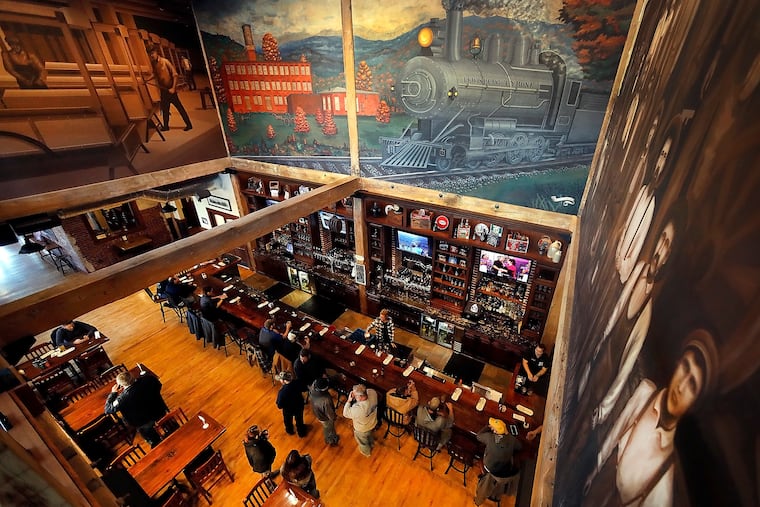How craft beer preserves history and draws tourists to small-town Pennsylvania
Pennsylvania, according to the Brewers Association, produces the most beer in the nation, at 3.7 million barrels each year.

MIFFLINBURG, Pa. — Horse-drawn buggies sit at red lights here, just feet from the quaint Colonials that line Chestnut Street. Head east, and there are miles of rolling farmlands. To the west, it’s the same.
But a small detour just a few blocks off Mifflinburg’s main drag reveals a brick warehouse that’s equal parts brewery and museum, with a boutique hotel and wedding facility above it, to boot. Rusty Rail Brewing Co.’s mind-boggling 37,500 square feet of space seems as if it could seat every resident in this central Pennsylvania town of 3,600. The brewery is adorned with murals and images of Mifflinburg’s industrial past, not to mention a few restored Model T Ford trucks that were partly built there.
Rusty Rail, which sits next to a 19th-century railroad line, has the scope one would expect to see at Disney World, not Union County, but Alison Feeney, a professor of geography and earth science at Shippensburg University, said more and more breweries like it are drawing tourists and preserving history across the great expanse between the state’s two largest cities.
“History can be perceived as dry and boring, and when you can go and sit in a place like this, and have a beer, it’s a really cool experience,” said Feeney, author of For the Love of Beer: Pennsylvania’s Breweries.
Pennsylvania, according to the Brewers Association, makes the most beer in the nation, at 3.7 million barrels annually, and only five states have more than its 282 craft breweries. Some brewers, such as Yards of Philadelphia, Tröegs of Hershey, and Appalachian Brewing Co. of Mechanicsburg, are widely distributed, with large brewpubs. Rusty Rail is rapidly expanding, pushing its beers into Pittsburgh and Philadelphia. Rusty Rail brewed 1,000 barrels in 2015, its opening year, and 5,000 barrels last year. After pouring millions of dollars into the husk of the century-old Mifflinburg Body Co., the brewer is trying to draw in beer enthusiasts who will travel far and wide for a pint.
“We get people from all over the place coming in,” general manager Rich Schrader said. “We’ve become a real destination.”
The Selin’s Grove Brewing Co., in downtown Selinsgrove, Snyder County, brews just under 300 barrels a year and doesn’t sell wholesale, but is in the mansion of Pennsylvania’s third governor, Simon Snyder. The property, listed in 1978 on the National Register of Historic Places, was formerly used as a gift shop.
“Instead of going to an Applebee’s, this fosters some local pride and local history,” co-owner Heather McNabb said. “There’s so many corporate restaurants, but here, you can say, ‘This is my brewery and my town,’ and it makes it fun to explore some places.”
McNabb said she’s named beers after Gov. Snyder, and her Captain Selin’s Cream Ale is named after the town’s founder. Brewpubs in Gettysburg have built around the history there as well, and in Shamokin, a former mining town in Northumberland County, the Lost Mined Brewing Co. was built to resemble a coal mine.
In Pittsburgh’s Lawrenceville neighborhood, craft brewing was responsible for saving a building few other businesses could have repurposed: a Roman Catholic church built in 1902.
At a recent Brewers of Pennsylvania meeting, president Chris Lampe, of Easton’s Weyerbacher Brewing Co., talked about breweries as economic engines, often anchoring distressed sections of cities. He cited breweries in Bethlehem and Allentown as examples.
“When you open a brewery, other businesses tend to follow,” Lampe said.
Juniata College and Penn College of Technology both have brewing courses. And Shippensburg, thanks to a Pennsylvania Liquor Control Board grant, also will be offering “brew science” courses. With brewing a $1.1 billion industry in Pennsylvania, Feeney said, the goal of the programs is to get more skilled workers who are ready to brew, rather than apprenticing at a brewery for years.
Feeney said about 100 active or pending breweries are in areas designated as rural by the U.S. Census Bureau.
“These breweries are preserving small traditional main streets, renovating unique architectural buildings, and telling local stories with their naming of their beers,” she said.
The owners of Rusty Rail, Paul and Eric John, made their money building modular homes and purchased the sprawling Mifflinburg warehouse in 2006. The brothers, Schrader said, basically loved beer and craftsmanship, which explains the level of detail that went into the brewpub.
“They were thinking let’s give something back to the community, to our workers. Let’s pay respect to the people who worked here,” Schrader said. “I didn’t use a contractor to build this that was less than 40 miles away. There’s not a brick in this building that didn’t come from this building.”